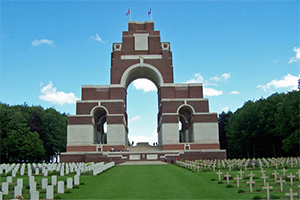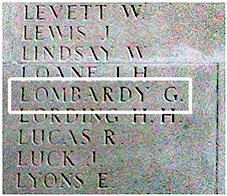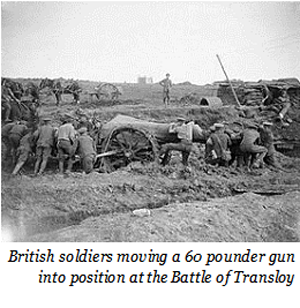First World War Project
George LOMBARDY (of Lynsted)
b. 1876 Private, Service Number G/9718 |


George was born in the spring of 1876. One quarter Italian by his grandfather, John, who was a native of Tuscany, Italy. His father William was born in London and his mother, Alice (née Gambrell), in Wychling. George was born, lived and enlisted in Sittingbourne. He had four older siblings: Elizabeth Ann, Alice, John and William, and three younger brothers, Walter, Frederick and Albert.
George and his family seem to have led peripatetic lives and familiar with untimely deaths and ventures overseas. His father died in 1896 at age 59. Sadly, just 2 years later on 9 May 1898, his mother was admitted to Chartham Lunatic Asylum where she died just 3½ months later on 25 July aged just 52.
At the time of the 1901 Census George was working as a brickfield labourer and boarding at 65 Albion Terrace, Sittingbourne. His younger brothers Frederick and Albert, who had been orphaned at ages 15 and 12, were living with their elder siblings Alice and William respectively. Alice was married to Harry John Baker and had 5 children before dying in 1904 aged 35.
In May 1906, George sailed aboard the "Siberian" to Halifax, Nova Scotia, no doubt in search of better prospects. Whilst he was away his older brother John died in 1907 aged 36. George would return home on 16 December 1911 aboard the "Victorian". He must have had positive news to report as he returned to Nova Scotia aboard the "Corsican", on 7 March 1912, accompanied by his younger married brothers Walter and Fred.
Walter's wife, Rose, and their two children, Lilian and Daisy, went to join him on 23 August 1912. Walter obviously made a life for himself and his family in Canada, dying in 1952 in Haldimand, Ontario. Rose died in 1960. Fred's wife and their daughter, Lilian, sailed to join him on 5 July 1912, but appeared to return shortly afterwards to Sittingbourne along with George. Fred would also served in WW1 in the Royal Engineers Railway Construction Company and died in Sittingbourne in 1968.
On 5 December 1912, George's older brother, William, sailed on the "Corinthic" to Wellington, New Zealand. William's wife Emily, daughter Pearl and younger brother Albert sailed to join him aboard the "Rotorua" on 3 July 1913. William remained in New Zealand, dying in Lower Hutt, Wellington, on 28 October 1952.
George's eldest sister, Elizabeth, remained in the area and married Walter Dive. They lived in Bakers Cottage, West End, Greenstreet, Lynsted; hence the fact that George was recorded on the Lynsted memorial. Elizabeth's child, Walter, and his wife are buried in Lynsted Churchyard extension.
George's service records were not available but we know he served for less than a year. We know his battalion took part in the Battle of Loos in 1915. In 1916, it fought in the Battles of Albert, Pozières and Transloy Ridges. The latter was fought from 1 - 18 October 1916, George was killed in action on the seventh day of the battle.
 The Battle of the Transloy Ridges took place during worsening weather and appalling battlefield conditions. At every stage the Germans put up a very strong resistance. The battle started on 1 October and it was not until the afternoon of 3 October that the objectives were secured. Follow-up attacks were delayed by atrocious weather but during this time George's Battalion War Diary states that all was quiet but suffered under heavy rain. The Battalion was involved in digging a communication trench. After a rest day on 5 October, they moved up to the front line trenches at Guedecourt on the night of 6 October.
The Battle of the Transloy Ridges took place during worsening weather and appalling battlefield conditions. At every stage the Germans put up a very strong resistance. The battle started on 1 October and it was not until the afternoon of 3 October that the objectives were secured. Follow-up attacks were delayed by atrocious weather but during this time George's Battalion War Diary states that all was quiet but suffered under heavy rain. The Battalion was involved in digging a communication trench. After a rest day on 5 October, they moved up to the front line trenches at Guedecourt on the night of 6 October.
On the morning of 7 October lengthy, extremely detailed and ambitious orders were issued. In retrospect, it is easy to see how these detailed plans could go disastrously wrong if any part of the strategy was to fail, each progressive action being reliant on the success of the preceding order. The orders concluded that rum would be offered to all those who wanted it prior to the advance.
At 1.45pm the men advanced. Six divisions were involved and the action resulted in heavy British casualties and little success except for the capture of Le Sars. The terrible conditions and continuous rain hampered the removal of casualties and stifled further forward moves. Some progress was made but the action failed to secure all battle objectives.
The War Diary entry for the day:
Quiet morning. At 1.30 pm the enemy opened heavy machine gun fire and shrapnel barrage on the front line. At 1.45 pm the attack commenced. Very heavy machine gun fire was opened, which held up "C" Company on the right. "A" and "B" companies reached the 1st objective with fairly heavy casualties but on advancing from 1st to 2nd objectives were completely held up with machine gun fire. Twenty men of "C" Company succeeded in getting into the trench, with troops from the 61st Brigade, and advanced with them.
The 1st objective was held until 12 midnight when the Battalion was relieved by the 6th Queen's. The 6th Royal West Kent Regiment were held up to the left by machine gun fire; the 61st Brigade on the right attained their objective. On relief the Battalion went back to bivouacs in Longueval Valley.
The following casualties were suffered during the day. Officers killed 8. (Lieunt Hatch, 2/Lt Ommaney, 2/Lt Norrie, 2/Lt Routley, 2/Lt Lott, 2/Lt Harnett, 2/Lt Moss, Capt Pagen Royal Army Medical Corps [the Battalion's Medical Officer]. Wounded 12. Lt Col T G Cope DSO, Lieunt Cumberbatch, Lieunt Bond, Lieunt Chapman, 2/Lt Kidd, 2/Lt Wooldridge, 2/Lt Taylor, 2/Lt Springay Mason, 2/Lt Turk, 2/Lt Jacobs. [2/Lt Hanmer was also killed.]
Other ranks killed, wounded and missing, 347.
The diary was written by Captain John Campbell Page, the only officer in the battalion that was not either killed or wounded on 7 October 1916. He led just 40 other ranks from the field after the Battle of the Transloy Ridges. He was subsequently awarded the Military Cross.
Interestingly, the diary records that only 4 prisoners were taken. The Battalion orders, issued that morning, emphasised the number of prisoners that would be put to use in retrieving the dead and injured.
The "Field State" list for the day prior to George's death compared to that completed on 13 October prior to the next attack, highlights other logistical losses:-
| FIGHTING STRENGTH | 6 October 1916 |
13 October 1916 |
Losses & gains |
| Officers | 41 |
19 |
-22 |
| Other ranks | 783 |
449 |
-334 |
| Riding horses | 13 |
13 |
|
| Pack horses | 41 |
43 |
+2 |
| Wagons and Lewis guns | 2 |
2 |
|
| Machine Guns | 10 |
6 |
-4 |
| Ambulances | 1 |
1 |
|
| Tool carts | 2 |
2 |
|
| Small arms ammunition | 5 |
5 |
|
| Water carts | 2 |
2 |
|
| Rifles | 749 |
444 |
-206 |
The days after George's death saw orders for a fresh attack issued late on 13 October. These ignored the desperate conditions and physical state of the attacking troops. On the 18 October the subsequent early morning assault witnessed heroic efforts to advance but minimal gains were made against resolute defenders, well supported by accurate artillery fire. At the end of the battle the advance could be measured in yards. Continuing bad weather as the war entered into another autumn meant that fighting on the Somme was by now coming to an end.
On 7 October, of the 144 men of the 6th Battalion killed during the Battle of Transloy Ridges, 129 died along with George. Only 43 have known graves. The others, like George, are commemorated on the Thiepval Memorial, pier and panel 5D.
George was Lynsted's oldest casualty and was posthumously awarded the British War and Victory medals. [See Appendix 1]
In March 1917, George's sister Elizabeth received his owed pay amounting to £4 12s 10d (£4.64p). In November she also received his War Gratuity of £3. [See Appendix 2] Taken together these amount to roughly £600 in today's money.

 World War 1 Pages
World War 1 Pages